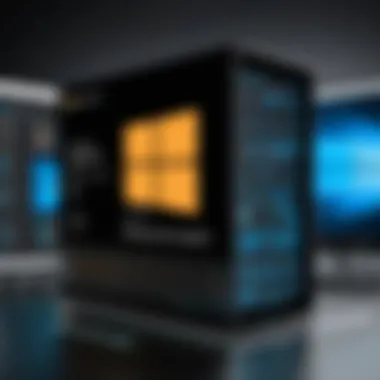In-Depth Review of Windows Server 2019 Essentials


Intro
In the rapidly evolving landscape of technology, small to medium-sized businesses (SMBs) often find themselves at a crossroads between adopting advanced features and managing their resources effectively. Windows Server 2019 Essentials presents a compelling solution tailored specifically for these enterprises. It combines accessibility with robust features suitable for managing a network, protecting data, and optimizing daily operations.
As companies grapple with the demands of modern digital environments, understanding the intricacies of solutions available becomes vital. This article aims to dissect the core aspects of Windows Server 2019 Essentials, exploring its functionalities, strengths, and how it can be instrumental in streamlining business processes.
Product Overview
Windows Server 2019 Essentials is designed to cater specifically to small businesses, generally supporting up to 25 users and 50 devices. This makes it an ideal choice for those who have limited IT support but need stable and comprehensive server capabilities.
Key Features
- User-Friendly Interface: Simplified management console makes it easy for non-technical users to navigate.
- Automatic Backup: Configurable backup options to local and cloud storage ensure business continuity.
- Remote Access Services: Enables users to connect to their office environment securely from anywhere.
- Integration with Office 365: Streamlined options for businesses already using Microsoft's cloud services.
- Advanced Security Measures: Supports Windows Defender and provides security updates, enhancing protection.
Technical Specifications
- Operating System: Windows Server 2019
- Architecture: 64-bit only
- Memory Requirements: Minimum of 2 GB RAM, recommend at least 4 GB for best performance.
- Processor: 1.4 GHz 64-bit processor, dual-core minimum recommended.
- Disk Space: At least 160 GB of disk space for installation.
Pricing Information
The cost of Windows Server 2019 Essentials sits around $425 for a standard license. It is important to note that this price can vary based on resellers and additional licensing for client access.
Performance Analysis
Understanding the actual performance of the software is paramount in making an informed decision.
Benchmark Results
Tests indicate that Windows Server 2019 Essentials operates effectively with moderate resource demand, ensuring responsive user experiences even when handling various simultaneous connections.
Real-World Use Cases
Businesses primarily utilizing Windows Server 2019 Essentials often report:
- Centralized File Storage: Streamlines file access among users, reducing the chaos of decentralized data management.
- Print Services Management: Simplifies printer access and management within the organization.
- Client-Server Application Running: Many applications can run smoothly on the server setup, facilitating administrative tasks.
Comparison with Competitors
When stacked against solutions like N-able and Synology, Windows Server 2019 Essentials holds its ground but may lack some high-end features offered by more specialized providers. However, its affordability and comprehensiveness make it a strong contender in the SMB arena.
Installation and Setup
Required Tools and Components
- Installation Media: USB drive or DVD with the server software.
- Network Configuration: A properly configured local area network (LAN) for optimal connectivity.
Step-by-Step Installation Guide
- Boot from the Installation Media: Insert the USB or DVD and reboot the server machine.
- Select the Installation Type: Choose 'Custom' when prompted during setup.
- Configure Settings: Follow the prompts to set the language, time zone, and username.
- Join a Network: Connect the server to a network for remote access functionality.
- Final Checks: Run through the configuration checklist post-installation to ensure all settings are correct.
Troubleshooting Common Issues
If users encounter a failure during installation, verifying hardware compatibility tends to be the first step. It's advisable to check system requirements and remove any unnecessary peripherals before retrying installation.
Pros and Cons
Advantages of the Product
- Simplicity: Designed with the non-tech-savvy in mind, encouraging adoption with little training.
- Affordability: A cost-effective solution for small businesses with tight budgets.
- Integrated Features: Combines server functions, making it a one-stop-shop for many needs.
Disadvantages or Limitations
- User Limitation: Capped at 25 users, which might not suit growing businesses.
- Limited Scalability: Not as easily scalable as other premium solutions once businesses expand.
Who It’s Best Suited For
A perfect fit for small businesses that require reliable server infrastructure but lack the resources to invest in extensive IT management and support.
Final Thoughts
Summary of Key Points
Windows Server 2019 Essentials stands out as a streamlined, supportive solution for SMEs seeking to enhance their network and data management efficiently. It balances essential functionalities with safety and accessibility.
Recommendations for Potential Buyers
Buyers should assess their current and future needs, ensuring not only compatibility but also whether they anticipate outgrowing the system limitations in a few years.
Future of the Technology or Product Line
With continuous advancements in cloud computing and shared services, the future may hold additional upgrades or versions that will enhance integration with other technologies, further strengthening the utility of Windows Server 2019 Essentials.
To sum up, Windows Server 2019 Essentials is tailor-made for those who desire both simplicity and reliability in their server operations.
For more information, you might check out articles on Wikipedia or community discussions on Reddit.
Overview of Windows Server Essentials
Understanding the landscape of Windows Server 2019 Essentials is pivotal for any small to medium-sized business aiming to leverage technology to improve operational efficiency. This specific version of Windows Server is tailored to address the distinct needs of smaller organizations without the heavy lifting often associated with enterprise-level systems. Not only does it offer a simplified deployment process, but it also enhances functionality tailored for businesses that require an accessible yet powerful server environment.
Intro to Server Essentials
Windows Server 2019 Essentials brings to the table a suite of features designed to streamline administrative tasks and improve accessibility. Unlike its more complex counterparts, this edition is neither overly intricate nor resource-intensive, making it an excellent choice for organizations that may not have an extensive IT department on hand.
One of the standout aspects of Server Essentials is its user-friendly interface that allows even those with minimal technical knowledge to manage their system effectively. The Essentials Dashboard serves as the nerve center, providing access to critical functions like user management, device monitoring, and server health checks, all presented in a coherent and visually appealing manner.
Target Audience and Use Cases


When considering who benefits most from Windows Server 2019 Essentials, the target audience primarily includes small business owners, IT consultants, and organizations with straightforward IT needs. These users often seek a balance between capabilities and ease of use.
Some common use cases encompass:
- File Sharing and Storage: Offering centralized storage solutions that enable users to access files easily.
- Remote Access Solutions: Allowing employees to work from various locations through secure remote access, a must-have in today’s digital work environment.
- Small Business Backup: Providing reliable backup solutions to safeguard data without complex configurations.
A business comprising a handful of employees can significantly enhance its capability with this server. The potential for growth and additional functionality means businesses can scale up smoothly when needed without the need for constant IT overhauls.
"Windows Server 2019 Essentials is not just a product; it's an enabler for small businesses to harness technology effectively."
Ultimately, this approach fosters an environment where smaller entities can utilize advanced functionalities typically reserved for larger firms. Its combination of simplicity, cost-effectiveness, and robust performance stands as a testament to its relevance in today’s ever-evolving business landscape.
Thus, diving into Windows Server 2019 Essentials equips businesses with the tools needed to optimize work processes while ensuring that even those with minimal technical background can find their footing in the world of server solutions.
System Requirements
When diving into the deployment and management of Windows Server 2019 Essentials, it’s vital to understand the system requirements. Setting up anything without knowing what's needed is like trying to build a house without blueprints; it may be done, but the results can be dire. The system requirements lay the groundwork and ensure that both hardware and software perform optimally, providing a robust framework for all the features Windows Server 2019 Essentials offers.
Hardware Specifications
The hardware specifications you choose will have a profound effect on system performance and the overall user experience. Some critical elements to consider include:
- Processor: A minimum of a 1.4 GHz 64-bit processor is necessary. Ideally, going for a multi-core processor can help distribute tasks effectively, improving response times for users.
- RAM: At least 8 GB of RAM is required, but if your business operates multiple applications, you may want to consider 16 GB or more. More RAM can facilitate smoother multitasking capabilities.
- Storage: A minimum of 32 GB of available disk space is needed. However, for better performance and future expansion, especially if you're planning on implementing virtualization or storing large files, going for SSDs (Solid State Drives) can considerably enhance speed and responsiveness.
- Network Interface: Ensure that you have at least one Ethernet network adapter. Multiple NICs can help with redundancy and load balancing in a more complex setup.
Failure to meet these hardware specifications means you might run into issues down the line, potentially leading to sluggish performance or system crashes. Always err on the side of caution and opt for hardware that not only meets but exceeds the requirements, it'll save you headaches later.
Software Prerequisites
Now let’s shift over to the software prerequisites which play a significant role, too. Getting the underlying software right is just as important as having the right hardware. Some elements to keep in mind include:
- Operating System: Windows Server 2019 Essentials must be installed on a supported operating system. You can't just throw any version you've got around; ensure compatibility.
- Domain Function Levels: If you're integrating with an existing Active Directory, your domain functional levels must be compatible. Windows Server 2012 and higher is typically acceptable here, but always check documentation to confirm specifics.
- Updates and Service Packs: Always keep your software up to date. Missing updates can lead to security vulnerabilities, which is the last thing any business wants when managing sensitive data.
- Application Compatibility: Any third-party apps or services should also be checked for compatibility with Windows Server 2019 Essentials. You don’t want to discover halfway through deployment that your essential applications won’t run as expected.
In summary, understanding and adhering to the outlined system requirements is foundational for the successful deployment and operation of Windows Server 2019 Essentials. Consider it your roadmap; without it, you may find yourself lost in the tech wilderness.
"Proper planning prevents poor performance." It's a simple adage, yet its truth never diminishes, especially in the world of IT.
Installation Process
Installing Windows Server 2019 Essentials is a crucial step in harnessing its features and capabilities for effective server management. This process is not just about putting software on a machine. It sets the stage for all the functionalities that follow and impacts how well the system will perform in the long run. A well-executed installation can lead to optimized performance, enhanced security, and improved user experience.
When businesses consider implementing a server, they must evaluate the installation process carefully. Understanding the prerequisites and following a systematic approach can be the difference between a smooth start and a troublesome one. This segment will discuss vital preparations needed before installation and provide a step-by-step guide to ensure nothing is overlooked.
Pre-Installation Checklist
Before diving into the installation, there’s a fair amount of groundwork to cover. Not having a checklist can be akin to sailing without a map—an easy way to end up lost in complications. Here's an outline of essential items to validate:
- System Requirements: Verify that the hardware meets the minimum specifications. This includes CPU, RAM, and disk space.
- Backup Measures: Ensure any existing data is properly backed up. Data loss is not an option, especially for businesses.
- Licensing Confirmation: Confirm that you have a valid license for Windows Server 2019 Essentials. Be sure to understand the licensing structure.
- Updates and Drivers: Check for available updates for your hardware and install necessary drivers. Keeping everything updated saves headaches later.
- Network Configuration: If possible, reserve a static IP for the server. This simplifies network management and remote access issues down the line.
Taking these steps can significantly mitigate potential hitches in the installation process.
Step-by-Step Installation Guide
Once preparations are set, it's smooth sailing if you follow the proper steps during installation. Below is a straightforward guide:
- Boot from Installation Media: Insert the installation USB drive or DVD and boot your server. Ensure your BIOS/UEFI settings enable booting from this device.
- Select Language and Preferences: When prompted, select the desired language, time, and keyboard settings. A small but essential first step.
- Install Now: Click on "Install Now" to begin the installation process. This initiates the installation wizard.
- Accept License Terms: Agree to the license terms to proceed. It’s always good practice to read these even if they tend to be quite long.
- Choose the Installation Type: Select the option for a new installation, bypassing the upgrade option. This is vital for a clean start.
- Select Destination Drive: Choose the disk partition where Windows Server will be installed. If needed, format any existing partitions carefully, ensuring not to delete important data.
- Begin Installation: Click on the Install button. The system will take care of the rest, but a watchful eye can catch any issues that may pop up.
- Set Up Admin Account: Once the installation completes, create an administrative user account and set a secure password. The importance of a strong password cannot be overstated here.
- Network Configuration: Set up your network settings. Amid a myriad of choices, opt for a static IP if you had previously planned it.
- Final Adjustments: After the primary setup, configure additional features and roles based on your business requirements. This could include file storage systems, print services, and so on.
Following this structured guide not only facilitates a successful installation but sets the groundwork for future management of Windows Server 2019 Essentials. Through careful preparation, a seamless installation can lead to countless benefits. Remember:
"An ounce of prevention is worth a pound of cure."
In the realm of server management, this holds true at every step of the way.
Key Features of Windows Server Essentials
When considering Windows Server 2019 Essentials, one cannot overlook the significance of its key features. These elements are designed to make life easier for small to medium-sized businesses (SMBs) that often juggle multiple tasks with limited resources. The server aims to streamline operations, enhance security, and offer tools that align closely with daily business needs.
Simplified Management Tools
One of the standout features of Windows Server 2019 Essentials is its simplified management tools. These tools are crafted for users who may not have extensive IT backgrounds, which means they can easily navigate the complexities of server management without feeling overwhelmed.
With an intuitive dashboard that consolidates essential functions, users have quick access to the features they need most. This includes settings for user accounts, storage, and security configurations—all in one accessible place. For example, Windows Admin Center allows administrators to manage their servers remotely with ease. Rather than needing to delve into complex command-line interfaces, a user-friendly graphical interface enables straightforward adjustments and monitoring.
Such accessibility not only saves time but also reduces the potential for errors during configuration. Imagine an office administrator trying to manage user accounts. Instead of wrestling with a maze of settings, they can simply click through an organized interface. This ultimately leads to increased productivity, freeing up time for more strategic tasks.
Remote Access and VPN
In today’s digital landscape, remote access and VPN capabilities have become not just convenient but essential. Windows Server 2019 Essentials caters to this increasingly mobile workforce by providing secure and easy methods for employees to connect remotely.
Utilizing built-in VPN and Remote Desktop features, businesses can ensure that their staff can access sensitive company data without compromising security protocols. Setting up a VPN on this server is a straightforward process, which benefits those less technically inclined. By connecting through a VPN, employees can work from various locations while maintaining a secure connection to the company network.
Here’s a small tip: Enabling the Network Policy and Access Services can help create a managed VPN environment that provides an additional layer of control over who accesses the network and how. This feature, when employed effectively, can remedy worries over unauthorized access, which is a paramount concern for many organizations.
Backup and Recovery Solutions
No matter how well a system is running, the unexpected can happen, which is why robust backup and recovery solutions are pivotal. Windows Server 2019 Essentials includes several options to safeguard data, ensuring that business continuity is never jeopardized.
You can configure automated backups to run at the frequency that best suits your operations—be it daily, weekly, or on a different timetable. With the Windows Server Backup tool, setting up these backups is a breeze. Perhaps more crucially, if a disaster does strike—whether it’s a technical failure or even a natural disaster—data can be quickly restored to minimize downtime. It’s about being prepared for the rainy days when your data is at risk.
"The ability to quickly restore a lost file or system can mean the difference between a manageable complication and a financial disaster."
The backup solutions fundamentally empower organizations by providing peace of mind and ensuring they can recover essential data without excessive hassle. By regularly backing up data to local drives or cloud solutions, businesses can navigate the challenges of unexpected data loss with relative ease.
In summary, the key features of Windows Server 2019 Essentials are tailored to create a seamless experience for its users. From simplified management to secure remote access, and effective backup solutions, this platform empowers SMBs to optimize their operations while keeping security and efficiency in mind. As companies continue to evolve with technology, tools like those found in Windows Server 2019 are indispensable for maintaining competitive edge.
User Management and Security
User management and security are foundational components of any server environment but bear significant weight in Windows Server 2019 Essentials. As small to medium-sized businesses rely heavily on technology, ensuring that the right users have the appropriate level of access to resources is paramount. Mistakes in this area can lead to dire consequences, ranging from loss of data to potential breaches of sensitive information. Thus, understanding how to effectively manage users and enforce security is critical for maintaining the integrity and reliability of the server environment.
Active Directory Integration


Active Directory (AD) is central to user management in Windows Server 2019 Essentials. It empowers administrators to create and manage user accounts, groups, and organizational units with relative ease. Integrating Active Directory simplifies processes by automatically enforcing security policies across organizations. This not only streamlines access control but also reduces the room for error in user permissions.
Utilizing Active Directory brings several advantages:
- Centralized Management: All user accounts can be managed from a single location, making it convenient to oversee access.
- Group Policies: Administrators can define settings that apply to groups of users, ensuring consistent application of policies.
- Single Sign-On: AD facilitates seamless access to various resources without requiring multiple logins, enhancing user experience while maintaining security.
The integration process generally involves the setup of a domain controller, which acts as a hub for all user-related functions. Through this connection, resources can be shared easily, tailored to specific needs.
User Roles and Permissions
In any IT setup, defining user roles and permissions is vital for operational efficiency and security. Windows Server 2019 Essentials allows administrators to assign specific roles to users, ensuring that each individual within the organization has access based on their responsibilities.
Establishing roles can help shape how information flows within the company. For instance:
- Administrators typically have full access to all resources.
- Standard Users might be restricted to specific applications or files, ensuring sensitive data remains protected.
- Guests usually have minimal access, which is particularly useful for temporary users who need limited interaction within the system.
Managing these specifications requires an understanding of the principle of least privilege, where each user is granted the minimum level of access necessary to perform their job. This prevents unauthorized access to sensitive information and is a best practice in mitigating risks.
Data Protection Strategies
As security threats evolve, so must the strategies businesses employ to protect their data. Windows Server 2019 Essentials offers robust mechanisms to safeguard important information. Several layers of protection can be employed:
- Backup Solutions: Regularly backing up data is essential. Microsoft's built-in backup options allow for automatic backups to local or cloud storage, ensuring that you can recover data in case of loss or corruption.
- User Account Control: This feature helps prevent unauthorized changes to the operating system. By requiring administrative approval for certain actions, it minimizes risk from malware or users with malicious intent.
- Encryption: Using BitLocker encryption on drives protects against unauthorized access by encrypting the entire volume. This way, even if physical access is gained, the data remains secure.
- Regular Audits: Keeping tabs on user activities through auditing tools can reveal unauthorized access or unusual behavior patterns. This makes it easier to identify potential security breaches early on.
"Implementation of stringent user management and security practices transforms potential vulnerabilities into secure environments. Businesses can face the future with confidence, knowing that their data is safeguarded against prevalent risks."
Networking Capabilities
Networking capabilities are often the backbone of any server solution, shaping how effectively organizations manage their resources and connect with others. In the case of Windows Server 2019 Essentials, networking not only facilitates seamless data transfer among users and devices but also enhances security and access controls. A solid grasp of these capabilities can greatly impact an organization’s efficiency and operational flow, especially for small to medium-sized businesses that rely on strong connections for daily tasks.
Configuration of Network Settings
Configuring network settings in Windows Server 2019 Essentials is a pivotal step toward establishing robust connectivity. It is imperative to carefully manage parameters such as IP address allocation, subnet masks, and gateway configurations. This can be achieved through the easily accessible Windows Admin Center, which allows for a user-friendly interface to adjust these settings.
When setting up your network, always keep in mind:
- Static vs. Dynamic IP Addressing: Static IPs provide stability, especially for servers that need constant access, while dynamic addressing through DHCP is beneficial for flexibility and ease of management.
- Subnet Masks: Understanding subnetting can help optimize local area networks and ensure secure communication between devices.
"In networking, simplicity often sharpens security."
During configuration, don't overlook security protocols, such as enabling firewall settings and configuring network access controls. It’s essential to ensure only authorized users can access sensitive data.
Utilizing DHCP and DNS Services
Dynamic Host Configuration Protocol (DHCP) and Domain Name System (DNS) services form the structural essentials for networking in Windows Server 2019 Essentials. These two services work hand-in-hand to simplify the process of connecting devices to the network.
DHCP Services
DHCP automates the IP address assignment process, removing the hassles tied to manual configurations. Each time a device connects to the network, DHCP assigns it a unique IP address, allowing for flexibility and scalability. It's worth noting:
- Automatic Reconfiguration: Devices do not need to be manually configured each time they connect.
- Address Pool Management: Network administrators can easily manage available IP addresses, creating a smoother operational flow.
DNS Services
DNS, on the other hand, translates user-friendly domain names into IP addresses that computers understand. This service enhances user experience while navigating networked resources. Some key takeaways are:
- User-Friendly Access: Users can connect to servers using names instead of hard-to-remember IP addresses.
- Load Distribution: DNS enables the deployment of multiple servers under the same domain, balancing the traffic load efficiently.
In sum, effectively configuring these networking services lays the groundwork for a well-functioning server environment. Taking time to fine-tune your DHCP and DNS settings not only facilitates better connectivity but also contributes to a more resilient and secure network architecture.
Application Server Features
When talking about Windows Server 2019 Essentials, it's crucial to touch on Application Server Features. These features enable organizations, especially small to medium-sized businesses, to leverage advanced capabilities that enhance productivity and streamline operations. These functionalities not only support various applications but also provide a backbone for web services, which is a key consideration as businesses increasingly pivot towards the digital landscape.
Having robust application server features means improved efficiency. For instance, it allows for centralized management, which simplifies IT administration. This allows companies to focus more on strategic initiatives rather than mundane maintenance tasks. As an added bonus, optimal application server performance can significantly lower operational costs.
Web Server Integration
One essential feature of Windows Server 2019 Essentials is its web server integration capabilities. Built on Internet Information Services (IIS), this integration allows users to host websites directly on the server. Moreover, it supports various web technologies, such as ASP.NET and PHP, making it versatile for developers.
The significance here is manifold. First, web server integration enables small businesses to maintain a web presence without requiring additional hardware or separate hosting services. They can manage everything in-house, from server health to security protocols. This empowers organizations, as they have total control over their web services.
- Security: With direct control, businesses can implement customized security measures to protect against common vulnerabilities.
- Customization: Tailoring the server environment to fit unique business needs is more manageable with integrated services.
- Cost-Effective: With no need for external hosting, companies save money while gaining flexibility.
File and Print Services
File and Print Services are another critical component of the Windows Server 2019 Essentials application server features. They enable efficient management of shared resources, including documents and printing. This functionality streamlines processes that involve multiple team members needing access to the same files or printers.
With Windows Server 2019 Essentials, organizations can easily set up and manage shared folders and printers, enhancing collaboration among team members. Employees can access files securely from various devices, allowing for more dynamic work environments.
Some noteworthy advantages include:
- Centralized Storage: All essential files can be stored on a networked server, which is more secure than local storage.
- Accessibility: Employees can access needed documents from anywhere in the office or remotely, boosting productivity.
- Cost Savings: Shared printing reduces the need for individual printers, cutting down on material costs.
"By effectively utilizing Application Server Features, businesses can transform their operational strategy, maximizing resources and enhancing their digital footprint."
Performance Monitoring and Optimization
Performance monitoring and optimization is a pivotal aspect of managing Windows Server 2019 Essentials, especially for small to medium-sized businesses. As organizations rely more on technology, ensuring that servers run smoothly becomes non-negotiable. Poor performance can lead to downtime, frustrated users, and ultimately lost revenue. Therefore, understanding the mechanisms behind monitoring performance and optimizing resources can make a significant difference in operation efficiency.
Utilizing Windows Admin Center
The Windows Admin Center serves as a centralized management platform, vital for the smooth operation of Windows Server 2019 Essentials. This tool simplifies the often complicated process of server management by offering a user-friendly interface. From basic configurations to advanced performance assessments, it brings everything under one roof.
Some benefits of the Windows Admin Center include:
- Real-time Monitoring: Admins can track system performance live. It gives insights into CPU usage, memory consumption, and disk activity, enabling immediate action when needed.
- Custom Dashboards: Tailoring your dashboard to reflect the metrics that matter most helps you spot trends and possible issues quickly.
- Integration with Azure: For businesses leveraging the cloud, the Admin Center provides seamless connectivity with Azure services, extending performance capabilities beyond on-premises limitations.


Generally, it's like having a control tower overseeing your server fleet—centralized, efficient, and indispensable.
Performance Metrics to Monitor
Monitoring performance is not just about observing distant indicators; it's about understanding key metrics that truly impact operations. Here are a few crucial metrics you should keep an eye on:
- CPU Utilization: High CPU usage can signal that the server is overwhelmed. Ideally, it should range below 80%. Consistently surpassing this threshold could require load balancing or upgrading hardware.
- Memory Usage: Memory leaks or improper configuration can eat up resources. Monitoring memory usage and its patterns is essential for ensuring applications run without hitch.
- Disk I/O: If disk read/write operations spike, it could cause data bottlenecks. Hence, assessments of how quickly data is being read from or written to storage become fundamental.
- Network Latency: Network delays can be detrimental, affecting user experience. Regular checks on latency between devices and servers can identify issues before they escalate.
- Service Response Times: Applications and services should respond within acceptable limits. Monitoring their response times ensures that users have a seamless experience.
Understanding these metrics not only aids in immediate troubleshooting but also informs strategic decisions, helping to plan better for future capacity needs and growth.
"In the realm of server management, knowledge of performance metrics is the sword and shield; it allows admins to defend their infrastructure against inefficiencies and outages."
By adopting a comprehensive performance monitoring strategy using tools like Windows Admin Center and focusing on key metrics, businesses can bolster their capability to optimize operations. This approach ensures that Windows Server 2019 Essentials can live up to its potential in supporting the organization's needs, ultimately leading to improved productivity and reliability.
Integration with Cloud Services
The integration of Windows Server 2019 Essentials with cloud services marks a significant stride for small and medium-sized businesses aiming to enhance their operational efficiency. In today’s digital landscape, where scalability, reliability, and security are paramount, cloud integration serves as a lifeline, providing businesses the agility needed to respond to changing demands. This section will explore how Windows Server engages with cloud services, particularly focusing on features provided by Azure, along with the critical aspect of backup functionalities.
Azure Integration Capabilities
Azure stands as a cornerstone in Microsoft's cloud offerings, presenting a suite of services that cater to a wide array of business needs. Integrating Windows Server 2019 Essentials with Azure enables businesses to unlock numerous capabilities that were previously too complex or costly to implement. A few of the key advantages include:
- Scalability: Allows businesses to scale applications as needed, which is fundamental for growth without incurring prohibitive costs.
- Disaster Recovery: Offers robust disaster recovery solutions, ensuring business continuity even in the face of unexpected events.
- Cost-Effectiveness: With pay-as-you-go models, companies can manage their expenses better and only pay for what they use.
"Integrating cloud services is not just about taking advantage of storage capabilities; it's about empowering businesses to innovate without the usual constraints and overheads."
Moreover, Azure provides management and virtualization tools that sync seamlessly with Windows Server. Businesses can use Azure Active Directory to manage identities across cloud and on-premise environments, simplifying user management while heightening security protocols. Overall, the integration capabilities of Azure with Windows Server 2019 Essentials signify a leap towards modernizing IT infrastructure.
Backup to Azure
Data is invaluable. Therefore, securing data is non-negotiable. One of the standout features of Windows Server 2019 Essentials is its robust backup solutions, with Azure playing a pivotal role. Here’s how backing up to Azure can enhance data protection for businesses:
- Offsite Backup: By utilizing Azure for offsite backups, your data is safeguarded against local failures or disasters, ensuring peace of mind.
- Automated Backups: The ability to automate backup schedules reduces the manual effort required, freeing up IT resources for more strategic tasks.
- Increased Speed of Recovery: The cloud enables quicker recovery times. Using Azure Blob storage for backups allows businesses to restore data quickly, minimizing downtime.
Troubleshooting Common Issues
Troubleshooting common issues is a vital aspect of managing Windows Server 2019 Essentials. Given its use in small to medium-sized businesses, any downtime can directly impact operations and productivity. This section aims to illuminate the various typical problems that may occur, guiding IT professionals toward clarity and resolution. Gaining familiarity with these issues not only aids in immediate problem-solving but also equips users with preventive strategies, ensuring a smoother operation overall. By focusing on common pitfalls, one can not only enhance the reliability of their server environment but also bolster confidence in their IT capabilities.
Identifying Common Problems
When delving into the world of Windows Server 2019 Essentials, it's essential to know the usual suspects that might rear their heads. Common problems might stem from updates, network configurations, or even user errors. Here’s a closer look:
- Performance Issues: Slow performance can often result from hardware constraints or misconfigured services. Monitoring server performance and resources can reveal CPU, memory, or disk bottlenecks.
- Connectivity Problems: If users can't access shared files or services, it may be due to network settings, firewall configurations, or even DHCP issues. Always double-check connections and settings.
- User Login Issues: Users may find themselves locked out due to incorrect credentials or account configurations. Verifying Active Directory settings can help to resolve this quickly.
- Backup Failures: A failed backup can spell disaster. Tracking down the logs for backup failures can provide insight into permission issues or configuration mishaps in the backup settings.
In identifying these problems early, businesses can take proactive measures, reducing the impact on overall productivity.
Effective Problem-Solving Techniques
Once common problems have been pinpointed, the next step is to apply effective techniques for resolution. Here are a few tried-and-true methods:
- Log Analysis: Windows Server provides detailed logs that can shed light on errors or warnings. Regularly check Event Viewer for clues. This is often the first step in understanding what went wrong.
- System Updates: Ensure that the server is always updated with the latest patches and updates. Many issues stem from outdated software that lacks the latest security and performance enhancements.
- Documentation Review: Keeping a handy log of previous issues and how they were resolved can be a lifesaver. This manual can be consulted when faced with similar problems in the future.
- Network Troubleshooting: Use built-in tools like the Network Troubleshooter to automatically diagnose and fix common networking issues. It’s like having a mechanic for your server's connectivity.
"Prevention is always better than cure. Stay one step ahead by monitoring your server’s health regularly."
In summary, understanding how to identify and troubleshoot common issues on Windows Server 2019 Essentials is not just a good practice—it's essential for the ongoing success and stability of any business relying on this powerful server solution.
Best Practices for Deployment
When it comes to deploying Windows Server 2019 Essentials, best practices play a crucial role. Following these principles not only streamlines the implementation but also sets the stage for long-term functionality and security. They ensure that businesses can maximize the use of their server environment while avoiding pitfalls that could lead to downtime or inefficiencies.
Planning for Scaling
One key aspect of planning for deployment is thinking ahead about scaling. In an environment where business needs can change overnight, having a clear scaling strategy can save a lot of headaches down the line. Here’s what to consider:
- Anticipate Future Needs: Understand your current resource usage and forecast future requirements. Think about how your business might grow and ensure your infrastructure can support increases in users and applications without a hitch.
- Select Scalable Hardware: Invest in hardware that can be upgraded. Choosing servers that allow for additional RAM or storage can provide flexibility to expand when needed.
- Utilize Virtualization: Leveraging virtualization technologies can significantly enhance scalability. Tools like Hyper-V allow for quick deployment of additional servers as your needs expand. This minimizes downtime and resource waste.
- Regular Performance Audits: Conducting regular assessments of server performance helps to identify any bottlenecks or limitations. It’s better to have clear insight rather than waiting until you hit a wall.
The goal should be to create an adaptable infrastructure that can handle increasing demands without requiring a complete overhaul of the system.
User Training and Support
One often-overlooked element of successful deployment involves user training and ongoing support. After all, a system is only as strong as its users’ ability to operate it effectively. Below are essential points to keep in mind:
- Conduct Training Sessions: Implement comprehensive training for all users, focusing on how to navigate and utilize the essential features of Windows Server 2019 Essentials. Training prevents frustration and fosters confidence among users.
- Create Documentation: Providing users with easy-to-follow documentation can help them self-train on functionalities that may be less intuitive. Clear, concise guidelines about common tasks can enhance productivity.
- Establish a Support System: Having a designated team or individual for technical support can make a world of difference. Users should know where to turn when technical issues arise or if they need additional training.
- Regular Feedback Loops: Create a mechanism for user feedback. This shows users that their insights matter and helps the IT department to address shortcomings or confusion surrounding the server’s management tools.
With proper training and support in place, the likelihood of users feeling overwhelmed or frustrated diminishes. This creates a more smooth-running operation, makes the most of the server capabilities, and, ultimately, enhances overall productivity.
"An effective deployment strategy is a blend of foresight and support for users, ensuring that both the technology and the people can thrive together."
Future of Windows Server Essentials
Understanding the future of Windows Server Essentials is essential for anyone looking to leverage this technology in their organization. As businesses increasingly migrate to hybrid environments, where on-premises infrastructures coexist with cloud services, knowing how Windows Server Essentials adapts to these trends can fuel smarter decisions.
Trends in Server Management
Emerging trends in server management influence how organizations deploy and maintain their server environments. Here are a few critical elements to consider:
- Automation: IT teams are turning towards automation tools to manage routine tasks. Windows Server Essentials is integrating more automation features to simplify deployment and configuration, freeing IT personnel from repetitive duties.
- Scalability: As businesses expand, so must their server capabilities. Windows Server Essentials is evolving to ensure that scaling up operations can happen smoothly without significant disruptions, aligning with other Azure services for seamless scaling.
- Security-first Approach: Cybersecurity remains a prominent concern. The future iterations of Windows Server Essentials are expected to integrate advanced security features to protect against evolving threats.
This shift toward proactive approaches influences how IT professionals manage server environments, leading to more resilient and adaptable infrastructures.
Hack on Windows Server Essentials
The term “hack” in the context of Windows Server Essentials doesn’t imply malicious behavior, but rather creative problem-solving and optimization techniques. Users and IT professionals can leverage various hacks to enhance their server's efficiency and performance.
- Scripting for Automation: By employing PowerShell scripts, routine tasks such as backups or user management can be automated effectively. Here’s a simple script example to automate routine server tasks:
Sample PowerShell Script
Get-EventLog -LogName Application -Newest 100 | Export-Csv -Path C:\Logs\ApplicationLogs.csv



